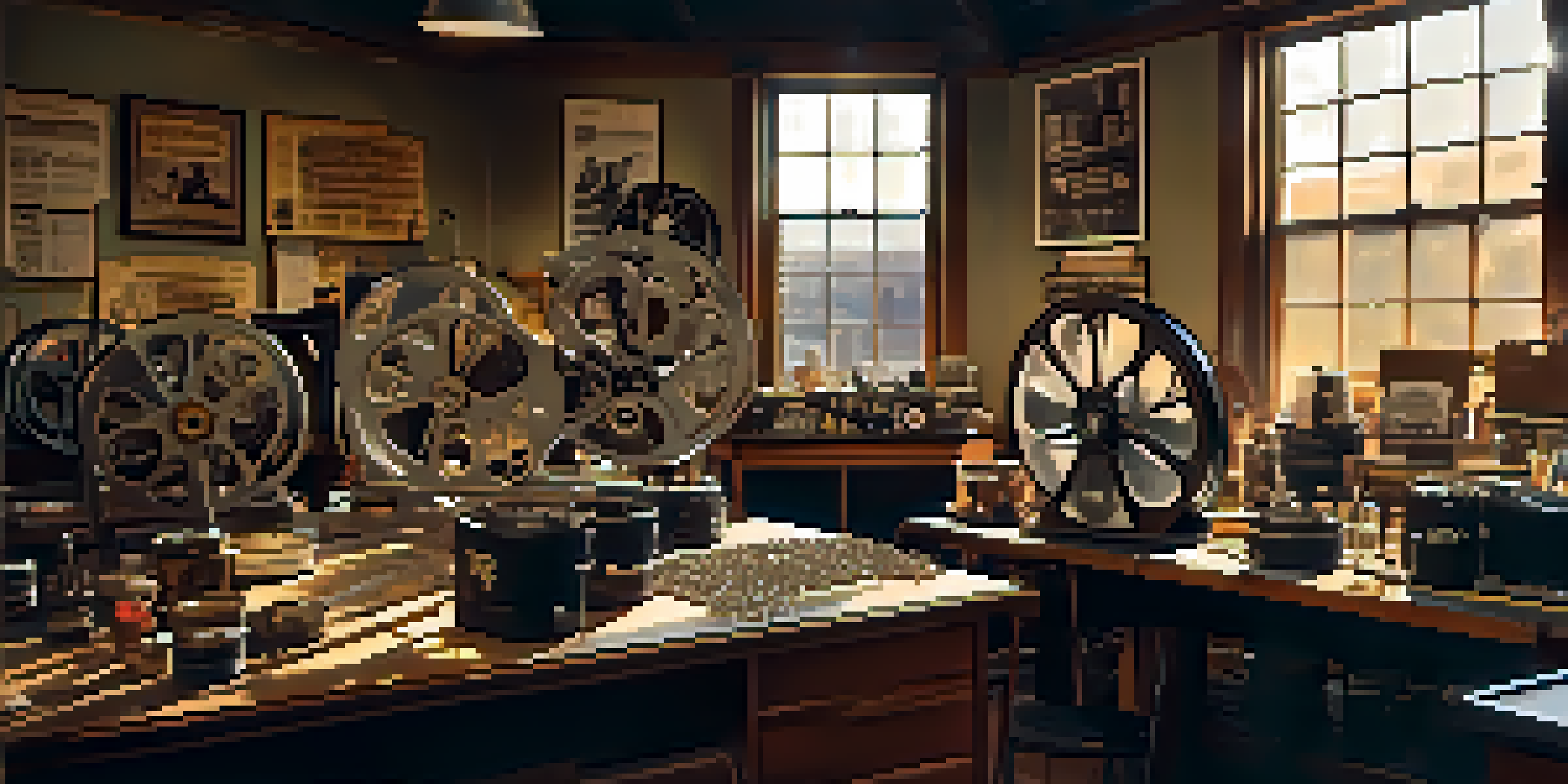Film Preservation Organizations: Key Players in the Field

Understanding Film Preservation: Why It Matters
Film preservation is the process of protecting and maintaining films for future generations. Just like how a photograph can fade over time, films are susceptible to deterioration due to factors like heat, humidity, and improper storage. Preserving these cinematic treasures ensures that we can continue to experience the artistry and history they encapsulate.
Film is a remarkably efficient medium for communicating ideas, emotions, and experiences that are otherwise difficult to define.
Imagine watching a classic movie and feeling transported to another era. Without preservation efforts, many iconic films could be lost forever, leaving gaps in our cultural narrative. These organizations not only save films but also keep the stories, emotions, and values they represent alive.
Moreover, the preservation process is not just about physical films; it also involves digitization and restoration. This means that even as technology evolves, we can preserve the essence of our cinematic past while making it accessible to modern audiences.
Key Players in Film Preservation Organizations
Several organizations are at the forefront of film preservation, each contributing uniquely to the field. The American Film Institute (AFI) and the Library of Congress are notable examples, both dedicated to safeguarding and promoting American cinema. They work tirelessly to ensure that films are not only preserved but also celebrated through screenings and educational programs.

Internationally, the International Federation of Film Archives (FIAF) plays a crucial role in fostering collaboration among film archives worldwide. This collective effort helps share resources and knowledge, ensuring that best practices in preservation are applied globally.
Importance of Film Preservation
Film preservation protects cinematic history, ensuring that future generations can experience the artistry and cultural narratives of classic films.
These organizations often rely on passionate volunteers and dedicated professionals who understand the significance of their work. Their commitment transforms these organizations into vibrant communities where film lovers and historians unite to protect cinematic heritage.
The Role of Technology in Film Preservation
Technology has significantly transformed the landscape of film preservation. With advancements in digital storage and restoration techniques, preserving films has become more efficient and effective. For instance, digital scanning allows for high-quality reproductions, making it easier to restore films that may have been damaged over time.
Preservation is not just about saving old films; it’s about maintaining our cultural heritage for future generations.
Moreover, technology enables organizations to reach wider audiences through online platforms. Many institutions now host virtual screenings, allowing people from all over the world to enjoy classic films that might not be available otherwise. This accessibility helps cultivate a new generation of film enthusiasts.
However, as technology evolves, it also presents challenges. Organizations must continuously adapt to new formats and ensure that digital files are preserved against obsolescence, maintaining their integrity for years to come.
Challenges Facing Film Preservation Efforts
Despite the best efforts of preservation organizations, numerous challenges remain. Funding is often a significant hurdle, as many organizations operate on tight budgets and rely heavily on donations and grants. This financial strain can limit their ability to acquire new technologies or expand their preservation initiatives.
Additionally, the physical condition of older films can pose a challenge. Many films are made from nitrate film stock, which is highly flammable and deteriorates quickly. Preserving these films requires specialized knowledge and resources that not all organizations possess.
Challenges in Preservation Efforts
Organizations face hurdles such as funding limitations, the fragile condition of older films, and the overwhelming number of films needing preservation.
Furthermore, the sheer volume of films in need of preservation can be overwhelming. With so many films produced each year, organizations must prioritize which ones to restore, leading to difficult decisions about which cinematic works to save first.
Case Studies: Successful Film Preservation Projects
One notable success story in film preservation is the restoration of 'The Wizard of Oz.' This beloved classic underwent extensive restoration to preserve its colors and clarity, ensuring that new audiences could enjoy it as intended. The project was a collaboration between several preservation organizations, showcasing the power of teamwork in this field.
Another inspiring example is the efforts to preserve silent films. Organizations like the San Francisco Silent Film Festival have worked diligently to restore and showcase these films, often pairing them with live music to enhance the viewing experience. This not only preserves the films but also engages audiences in a unique way.
These case studies highlight the importance of collaboration and innovation in film preservation. By sharing resources and expertise, organizations can achieve remarkable results, ensuring that cinematic masterpieces remain accessible for generations to come.
The Impact of Film Preservation on Culture and Education
Film preservation plays a crucial role in cultural education, allowing audiences to connect with historical contexts and societal issues through cinema. Educational programs often accompany preservation efforts, providing valuable insights into the films’ significance and the eras they represent. These initiatives help cultivate a deeper appreciation for the art of filmmaking.
Moreover, preserved films serve as primary sources for researchers and historians. They offer a window into the past, shedding light on cultural norms, societal changes, and artistic movements. By studying these films, we gain a better understanding of the world and its evolution.
Community Engagement in Preservation
Film preservation fosters community involvement through screenings and educational programs, enhancing appreciation for cinematic heritage.
Furthermore, film preservation fosters community engagement. Local screenings and events often create a space for dialogue about the films’ themes and their relevance today, bringing people together through shared experiences and discussions.
How You Can Support Film Preservation Efforts
Supporting film preservation organizations can be as simple as attending screenings or donating to their initiatives. Many organizations rely on the public's passion for cinema to fund their projects, making even small contributions impactful. Your support helps ensure that films are preserved for future generations to enjoy.
Additionally, spreading awareness about the importance of film preservation is vital. By sharing information with friends and family or engaging in discussions online, you can help foster a greater appreciation for the efforts of these dedicated organizations. Every conversation can spark interest and encourage others to get involved.

Finally, consider volunteering your time or skills. Many organizations welcome volunteers to assist with various tasks, from archival work to event planning. Your involvement can make a significant difference, helping to preserve the cinematic treasures that enrich our cultural landscape.